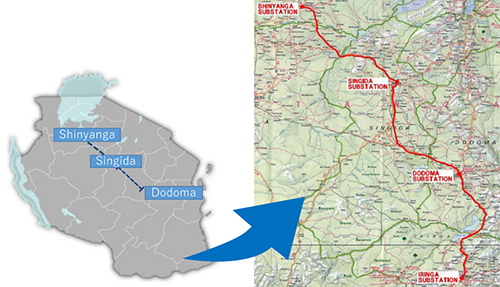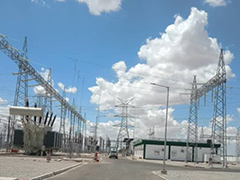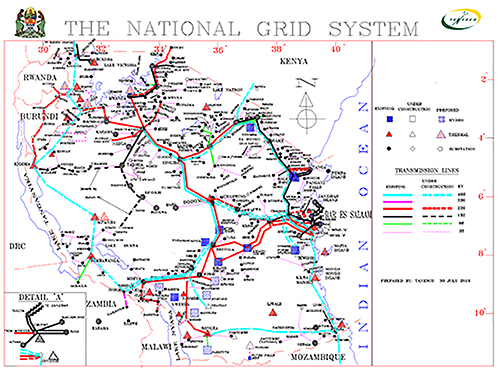Background of the project
Tanzania has an estimated population of about 58 million, growing approximately 5 to 6 percent annually. It has a land area of about 945,087 sq. km and is well endowed with natural resources such as hydropower, tin, iron ore, coal, gemstones, gold, natural gas, geothermal, and nickel. Topography and climatic conditions allow the cultivation of crops on about 54 percent of the land area. (World Bank, Implementation Completion and Results Report for Tanzania - Backbone Transmission Investment Project (2017) and others)
Electricity plays a vital role for the country to support its increasing economic growth as well as improve people's living standards. Insufficient transmission capacity and rapid power demand growth have resulted in deterioration in the quality of service due to repeated and prolonged outages and frequency fluctuations.
The JICA co-financed with the African Development Bank (AfDB) to a part of the Backbone Transmission Investment Project under concessional loan scheme. The loan agreement was signed in December, 2010 and the loan amount is up to 6.48 billion Japanese Yen (equivalent to approximately 58 million USD and 132 billion TZS respectively). The project is listed on a power system master plan in Tanzania and recognized as one of the high priority items in the plan.
A concept of establishment of backbone transmission line is supported by several Development Partners (DPs). In addition to JICA and AfDB, European Investment Bank, World Bank, and Korean EXIM Bank finance the project for construction of both 400kV Transmission line and 220kV substations.
Construction of 400 kV transmission line for connecting power generation area and power demand area
The whole backbone project concept has a component of 670 km long double circuit overhead line from Iringa to Shinyanga, designed and equipped for 400 kV level. Currently it is operated at 220 kV with a transmission capacity of 550 MW to support the critical situation in the North-Western Grid. Before the project, the existing single-circuit line from Iringa to Shinyanga via Dodoma and Singida was operating at its thermal limits. In 670km transmission line, JICA and AfDB co-finance to a section between Dodoma to Shingida which is approximately 217km.
Power is generated at Lower Kihansi, Kidatu, and Mtera, and transmitted to the existing substations of Iringa, Dodoma, Singida, and Shinyanga. The project improves the high transmission losses, the power system reliability, and the voltage situation. This improvement contributes to boost the economy in the North-western part of the country where is one of the fast-growing part in the country.

Map showing regions routing of the lines built by the project (Source: JICA (Left), TANESCO (Right))
Upgrading of the Zuzu Substation (Dodoma)
Dodoma is the capital city of Tanzania. Substations in Dodoma have a regional connections including future projects such as the Dodoma ring circuit and solar power project.
The project finance is also used to build the Zuzu substation in Dodoma. Before implementation of the project, the substation was equipped with 2 x 20MVA, 220/33kV with a maximum capacity of supplying power up to 48MW. The project increases the capacity of the substation by adding 2 x 125MVA, 220/33kV power transformers which can deliver up to approximately 200MW. Among the substations in Dodoma, the Zuzu substation is a core substation connecting to three other substations. Thus, the upgrade enables the substation to cater electricity for Dodoma city where its Demand is rapidly growing. After the Government decided to shift to the Capital City of Dodoma the maximum demand increased up to 45MW as of 2021. This shows that the backbone project came at the right time and rescued the situation as the old transformer would have overloaded and necessitated load shedding.
It is also important as a tapping point to one of big projects in the country which is known as The Julius Nyerere Hydro Power Project (JNHPP) with a capacity of 2,115MW, and a point to provide power to the Standard Gauge Railway (SGR) system in Tanzania, which is currently under construction.

Picture of newly constructed Zuzu Substation
(Source: TANESCO )
Impact to regional power pools
Not only domestic impact, establishment of the backbone transmission line has a regional impact in the Sub-Sahara African area. The backbone line enable Tanzania to join regional power pools such as the East African Power Pool (EAPP), the South African Power Pool (SAPP) and the Nile Basin Power Pool (NBPP) as a part of inter-national transmission line among Ethiopia, Kenya, Tanzania, and Zambia. The backbone transmission line also becomes a part of the Nile Equatorial Lakes Subsidiary Action Program, which intends to transfer 3,000 MW from Ethiopia to Kenya, Uganda, Rwanda, Burundi, Tanzania, and Zambia.
The routing of the lines is almost parallel to the Northeast and South-West borders of Tanzania respectively with Kenya and Zambia/Malawi. According to its geographic central position, the backbone project works as an ideal connector among regional power pools
The power exchange will occur between the countries in cheap power tariff that will be agreed among those countries hence stable and sufficient power supply.
JICA and AfDB also co-financed the project aims to build 414 km of 400 kV overhead line from Singida, to Namanga via Arusha. And further, this line connion with Isinya SS (Kenya). This project also contributes to establish regional power pools.

National grid of Tanzania. This Map shows a concept of interconnection with neighbouring countries such as interconnection to Burundi, Kenya, Malawi, Mozambique, Rwanda and Zambia (Source: TANESCO)





scroll